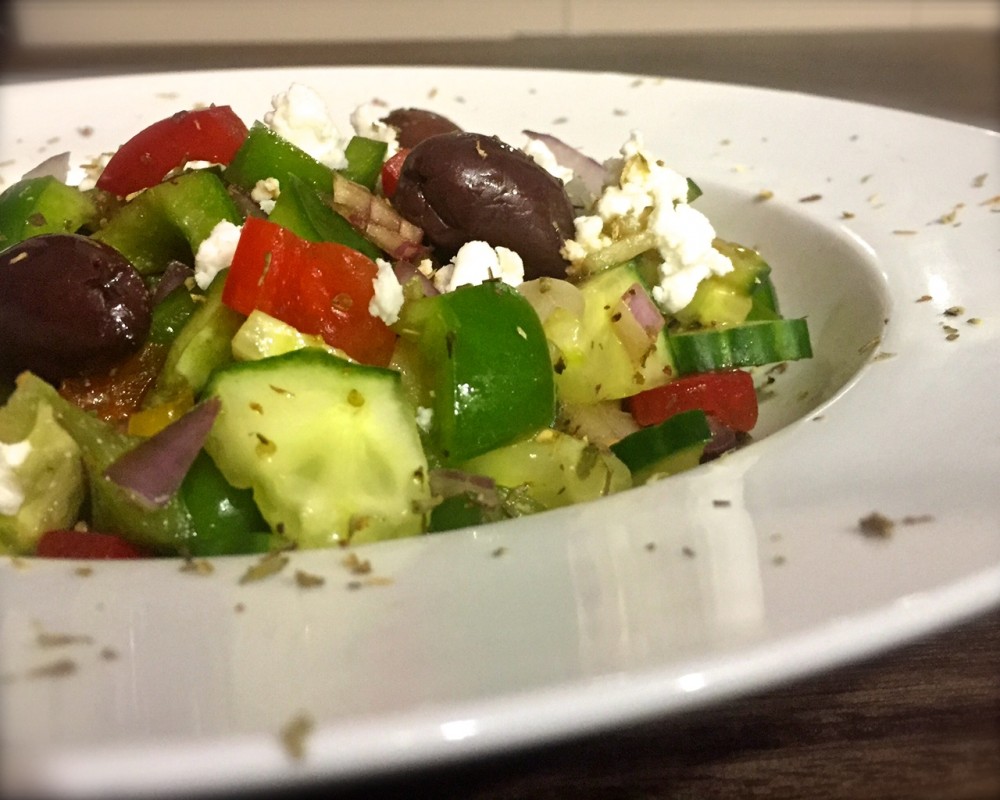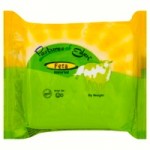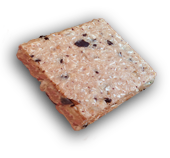Growing up in Greek household, I fell in love with healthy Greek cooking as a child and wanted to not only eat it but to prepare it myself. Some of my fondest childhood memories are of cooking with my mother Dawn Paidoussi, who is an amazing cook now living her dream operating a small cafe in Johannesburg called The Office at Woodlands! We’re so proud of her!
Having been so spoiled, I’m quick to spot a fraudulent Greek Salad when I see it! Skip the faux Greek salad in most restaurants and grocery stores. Tossing a bowl of pale, oil-doused iceberg lettuce with a few black olives and chunks of hard feta doesn’t make a Greek salad. Instead, try this traditional Greek Village Salad with added garbanzo beans for protein. Notice there’s no lettuce in this recipe? That’s not an error. Traditional Greek salads do not contain lettuce, especially not iceberg which is merely a cheap, nutrient-devoid filler in many restaurants.
Read on to see how we cut 29g of fat and 1138mg sodium from a traditional Greek salad!

 Sure, cheese is high in fat. But, if you’re going to eat cheese, make it worth it! For the creamiest, most satisfying feta sold in this country, try Pastures of Eden Sheep’s Milk Feta from Trader Joe’s. We also recently discovered this same exquisite Israeli feta sold in a two-pack under name Tnuva at Costco. Not only does this cheese add tremendous flavor and texture to any recipe, but many people with dairy allergies, including my lactose-intolerant wife, find sheep milk cheese easier to digest as it is free of hormones and additives in pasteurized cow’s milk.
Sure, cheese is high in fat. But, if you’re going to eat cheese, make it worth it! For the creamiest, most satisfying feta sold in this country, try Pastures of Eden Sheep’s Milk Feta from Trader Joe’s. We also recently discovered this same exquisite Israeli feta sold in a two-pack under name Tnuva at Costco. Not only does this cheese add tremendous flavor and texture to any recipe, but many people with dairy allergies, including my lactose-intolerant wife, find sheep milk cheese easier to digest as it is free of hormones and additives in pasteurized cow’s milk.
HOW’D WE LOWER THE FAT & SODIUM?
1. Since this feta is so flavorful and we crumble it into smaller pieces, we use only about 1/3 of the cheese than a traditional Greek salad recipe requests.
2. We dice each of our Kalamata olives into 6-8 pieces, dispersing that delicious salty flavor to every bite and allowing us to use only about 1/3 of olives in a traditional Greek salad.
3. While olive oil does contain heart healthy monounsaturated fats, many a Greek salad has been guilty of olive oil overhaul! We further reduced fat in this recipe by replacing some of the olive oil with olive juice.
4. We skipped the salt in the dressing.

INGREDIENTS
*As always, please use organic ingredients for YOUR health!
2 large tomatoes, chopped
1 large English cucumber, chopped
1 green bell pepper, chopped
1/2 medium red onion, diced
1 15 oz can garbanzo beans, drained and rinsed
2 Tbsp sheep’s milk feta, crumbled into small pieces
10 kalamata olives, diced
2 Tbsp olive juice for additional flavor
1 Tbsp olive oil
2 Tbsp red wine vinegar
1 Tbsp balsamic vinegar
1 Tbsp dried oregano
DIRECTIONS
Place all chopped fresh vegetables and garbanzo beans into a large bowl. Add the dried oregano, feta cheese and olives. In a small cup combine olive juice, olive oil, red wine vinegar and balsamic vinegar, whisk together using a fork. Pour dressing over the salad & toss. Allow to sit for 10 minutes before serving to allow flavors to develop.
* If preparing large salad to eat over several meals, hold on dressing whole salad to prolong freshness. Instead, dress each bowl of salad only when you’re ready to eat it.
Recipe makes about 4 large 3-cup servings. Here’s that Nutrition Info!
| Calories | Fat | Sodium | Protein | Carbs | Fiber | Sugar | |
| F+F Greek Salad with Protein | 220 | 5 | 552 | 10 | 36 | 7 | 6 |
| Panera Bread Greek Salad | 370 | 34 | 1690 | 10 | 14 | 5 | 4 |
Love F+F’s Greek Salad? Try our Hummus Recipe!
Enjoy twice as much of this delicious creamy garbanzo bean dip when you drastically reduce sodium & fat! All you need is a high-speed blender and 5 minutes!







